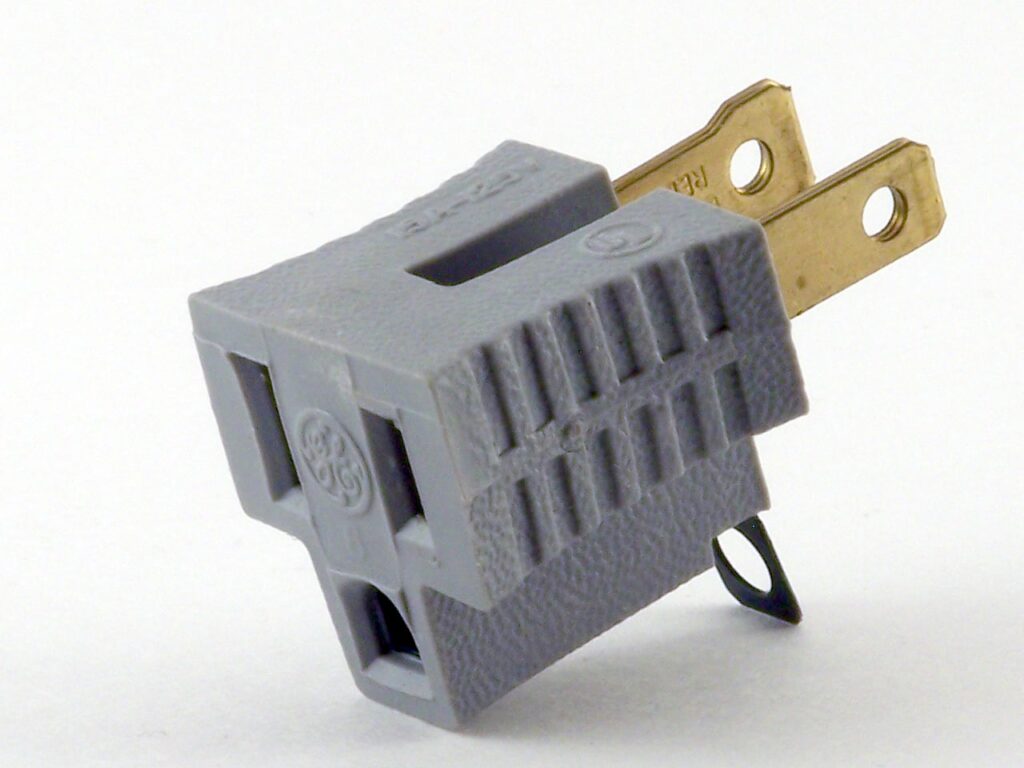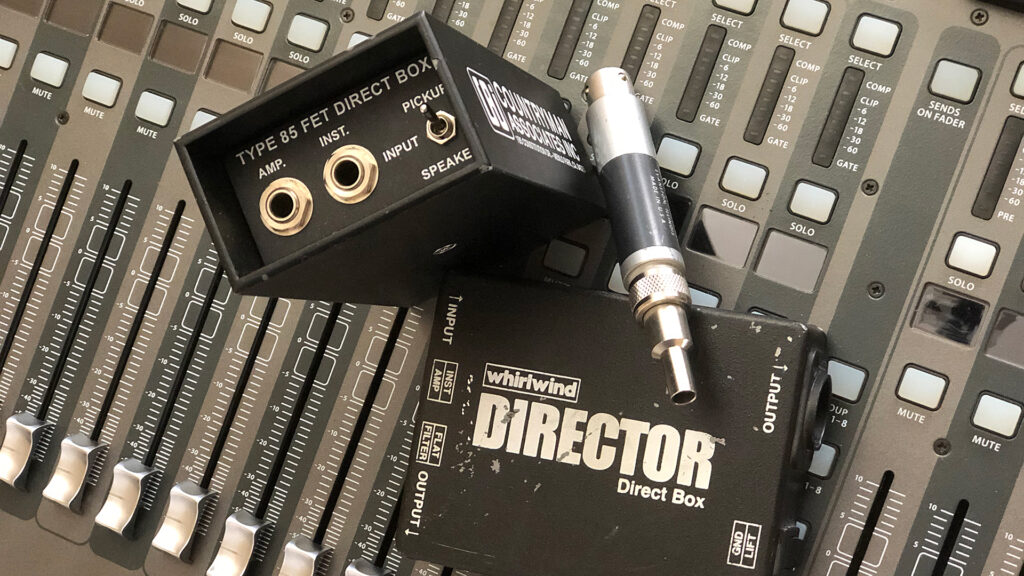DI boxes, DI’s, direct boxes all stand for the same thing, Direct Injection Box. These are a very valuable tool in live sound and can help fix a lot of problems that you might run into!
Pickups in Guitars & Bass
Most all of the electric guitars, bass guitars, and some acoustic guitars will have a pickup inside of the guitar to pick up the sound. These can be piezo or magnetic pickups and they ‘pick up’ the physical vibrations of the instrument or the magnetic field of the strings and turn that into and electric signal which is sent down the instrument cable to your guitar amp or preamp.
Impedance & Load
These pickups need what is called a ‘high-impedance load’ to function correctly. This is typically going to be above 1M Ω. This is often referred to as a high-z.
When you take a guitar pickup directly into a console, there is going to be an impedance mismatch. This is because the audio console is going to have an input impedance anywhere from 150 – 20,000 Ω. If you were to plug in a guitar directly into this, the pickup will actually change the tonality of the instrument and not function correctly.
Enter DI Boxes
DI Boxes use a ‘passive’ transformer or an ‘active’ electronic circuitry to transform the high impedance load to a low impedance load so that both the guitar and the audio consoles receive the correct load. This in turn brings out the most accurate tonality of your instrument and ‘injects’ it into your console.
Active vs. Passive?
There are two types of DI boxes, one is passive the other is active. Both yield the same result, i.e. high impedance to low impedance load matching. However, there are some advantages of passive and some advantages of active.
Active Direct Boxes
Active direct boxes use active circuitry with a preamp to perform the impedance matching. Often times there is a gain stage that boosts the signal of the source to a higher level, then outputs that higher level through an output stage to go off to the audio console. The benefit of this is that the active DI box can put a very high impedance load to the input, some going as high as 10M Ω (like the Radial PZ-DI). This high impedance along with the preamp stage will often yield pleasing results for acoustic guitars and bass guitars that use passive circuitry inside of the physical instrument.
To power the active circuitry inside of a direct box, +48v phantom power or an internal battery is required.
Passive Direct Boxes
Passive direct boxes use a transformer to perform the impedance matching. They do this by using windings of wire around a core creating a magnetic bridge. The transformer allows alternating current (audio signal) to pass through but will block direct current which makes them very efficient at blocking noise and ground hum or ground loops.
The benefit of a passive DI box is that if you have a very loud signal source, an active DI box can go from no distortion to lots of distortion very quickly. The transformers built into passive DI boxes don’t distort or clip in the same way as the active brethren. A transformer will ‘saturate’ the core and cause a natural compression which is pleasing to the ear.
The only downside of passive direct boxes is that the quality of the DI box solely relies on the quality of the transformer which can make them expensive.
When to use Passive vs. Active?
It is a good rule of thumb to use a passive DI box when it is an active circuitry instrument, like a keyboard. Keyboards will have gain stages built into the instrument and will yield a higher level signal output. I’m always trying to reduce the number of gain stages in an audio system to keep noise to a minimum.
When the instrument is passive, like a bass guitar, use an active DI box. This is especially true when it is a piezo pickup. This will help load that guitar with the very high impedance that the pickup needs to sound at its best.
Recommended DI Boxes:
I wanted to recommend some DI boxes for you if you are shopping around for some. These links below are Affiliate links so purchasing through this link will help support me at no additional cost to you, so thank you!
Active DI Boxes:
Rupert Neve RNDI : (~$270)
The Rupert Neve Designs Active DI Box is by far my favorite DI box for bass guitar and acoustic guitar. These boxes sound amazing and you really can’t go wrong with putting this on any source.
Radial J48: (~$200)
The Radial J48 Active DI Box is another solid sounding direct box. This is another go to if I have used up all of my Neve RNDI’s and is great for really quiet acoustic guitars. Radial also makes a J48 Stereo version of this DI box.
Radial Pro48 Active Direct Box: (~$100)
The Radial Pro48 Active Direct Box is going to be a more budget-friendly solution for an active DI box need. This will still give you a great active DI box, just with a lower price tag.
Passive DI Boxes:
Radial JDI Passive Direct Box: (~$200)
The Radial JDI Passive Direct Box houses a Jensen transformer and sounds very good. It can also handle those really high output instruments like a Nord keyboard with adding some great natural core saturation compression with the transformer. Radial also makes a JDI Stereo version of this DI box.
Radial ProDI Passive Direct Box: (~$100)
If you are looking for a middle of the road priced DI box, the Radial ProDI Passive Direct Box is a great choice for you. This is going to give you a great-sounding DI box at a lower price than the Radial JDI. Radial also offers this in a stereo version which is called the Radial ProD2.
DI Boxes for Computers:
Radial ProAV2 Stereo Direct Box: (~$170)
If you are needing to interface a computer or iPod to your audio console but need to maintain a low-noise signal, the Radial ProAV2 is a really great solution.
DI Box for Piezo Pickups:
Radial PZ-DI Piezo Optimized DI Box: (~$230)
The Radial PZ-DI is a DI Box that is optimized for a piezo pickup. This offers a load switch that is variable from 220k Ω, 1M Ω, and 10M Ω.
Ground Loops:
Ground loops are the hum and buzz that you hear when you have a source connected into a different electrical circuit as your sound board. What is happening here is that the ground potential of both the sound board and the keyboard are at different levels which allows voltage to travel where it shouldn’t. This turns into the 60 cycle hum that we get in the US. A fun tidbit is that the fundamental frequency of the hum is correlated to the frequency of the power generation. So, in countries that have 50Hz power, the hum will occur at 50Hz. Countries that have 60Hz power, like the US, will have the hum occur at 60Hz.
Direct boxes have a ground lift switch which will use the transformer or active circuitry to remove the ground potential between the source and the destination.
Save A Life, Literally!
Please, please, please NEVER use this:

This is an adapter to adapt a NEMA 1-15R to a NEMA 5-15P which adds the ground. The ground tab that you see at the bottom is required to be connected to electrical ground. If it is not, it will create a serious safety problem.
If an electrical fault happens in one device that is using this, high voltage and high current electricity will flow through all of the cables that are attached. Often times, this will electrocute any individuals touching these devices.
Please, if you ever find a venue using these, immediately unplug that equipment, remove this plug, take it with you (away from the venue) and throw it away. The inconvenience of not being able to use that piece of gear is small in comparison to someone’s life. You can then use this moment to teach that venue how to use a direct box to safely fix the ground problem.
